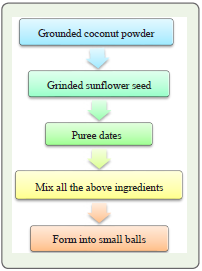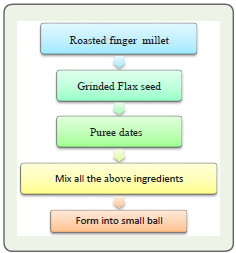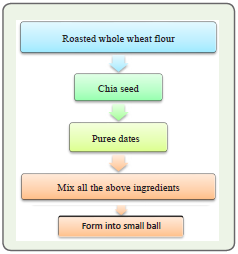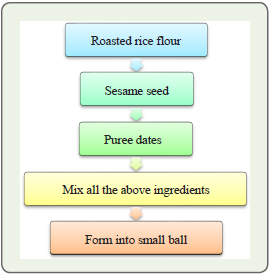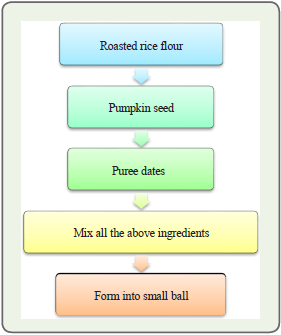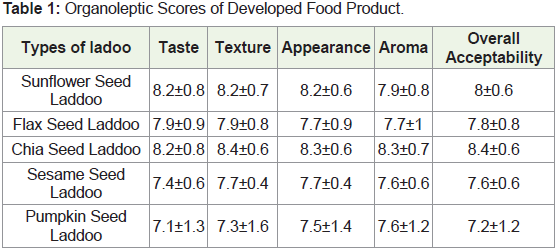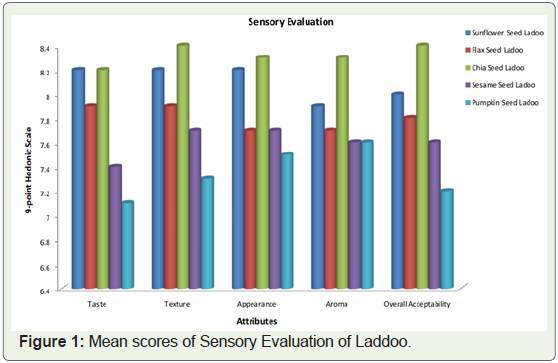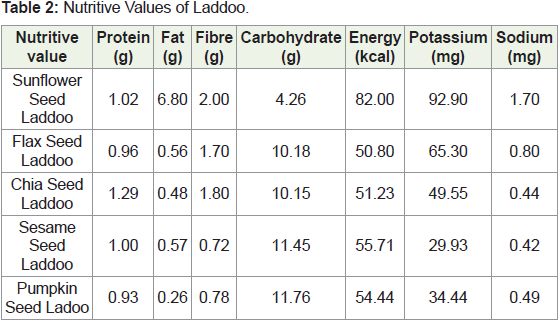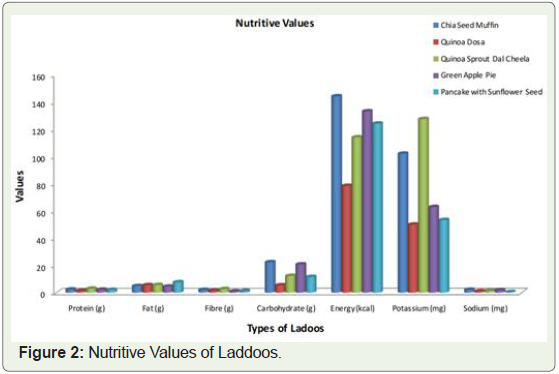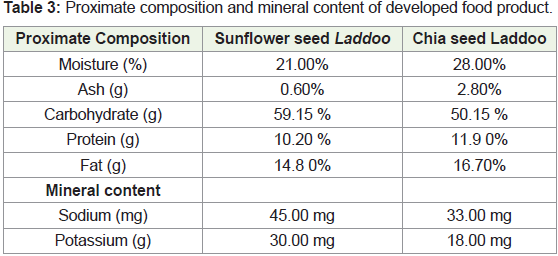Research Article
Development and Nutritional Evaluation of Laddoos Low in Sodium
Shristi Chetri*
Clinical Nutritionist, Independent Researcher
*Corresponding author: Shristi Chetri, Clinical Nutritionist, Independent Researcher, India, E-mail:shristichetri18@gmail.com
Article Information: Submission: 11/07/2022; Accepted: 10/10/2022; Published: 14/10/2022
Copyright: © 2022 Chetri S. This is an open access article distributed under the Creative Commons Attribution License, which permits
unrestricted use, distribution, and reproduction in any medium, provided the original work is properly cited.
Abstract
The study was taken up with the objective of development of food products low in sodium to find out their acceptability, nutritive value, proximate
composition and mineral content of most acceptable low sodium products. Five recipes in total were evolved. Sensory evaluations of these recipes were done
by selected panel of 10 judges based on a 9-Point Hedonic Scale. Product low in sodium content were being developed, namely Sunflower seed laddoo,
Flex Seed laddoo, Chia seed laddoo, Sesame seed laddoo, and Pumpkin seed laddoo. These were standardised in the laboratory after several trials. Result
showed that among the low sodium product. Sunflower seed laddoo and Chia seed laddoo were highly acceptable as they scored 8 and 8.4 respectively.
Keywords
Low Sodium, Hedonic scale, Sensory evaluation, Overall acceptability, Nutritive value
Introduction
Hypertension, defined as systolic blood pressure >140 mmHg or
diastolic blood pressure > 90 mmHg. Hypertension is commonest
chronic non communicable disorder found all over world. It is
also called as silent killer because in this patient remain mostly
asymptomatic, but on the other hand it causes target organ damage it
is also a major risk factor for Coronary vascular diseases like Stroke
and myocardial infarction. It is a global health problem affecting the
people of different ethnicity and ages around the world. In modern
medicine the aim of the treatment for hypertension is to prevent the
risk of coronary heart disease & cardiovascular disease. Hypertension
is responsible for 57% of stroke deaths and 24% of coronary heart
disease deaths in India. As per the statistics of Directorate General of
Health Services, Ministry of Health and Family Welfare, Government
of India, the overall prevalence of hypertension in India by 2020 will
be 159.46/1000 population. Hypertension will be the major cause of
death and disability by the end. The prevalence of hypertension is
increasing in both rural and urban communities (1-3).
Materials & Methods
Standardisation and development of product low in sodium:
The selected recipes were cooked in the laboratory of Food and Nutrition, Government Home Science College Sector 10 D,
Chandigarh. After cleaning and removing an inedible portions,
the ingredients required for each recipe were weighed on an electronic
food balance. The products were developed as per the details given
below:Sunflower Seed Laddoo: Methods and list of ingredients used for
the preparation of the sunflower seed laddoo.
Flax Seed Laddoo: Methods and list of ingredients used for the
preparation of the Flexseed Laddoo.
Chia Seed Laddoo: Methods and list of ingredients used for the
preparation of the Chia Seed Laddoo.
Sesame Seed Laddoo: Methods and list of ingredients used for
the preparation of the Sesame Seed Laddoo.
Pumpkin Seed Laddoo: Methods and list of ingredients used for
the preparation of the Pumpkin Seed Laddoo.
Sensory evaluation: Acceptance or rejection of food is largely
based on the stimulus of the sense organs of an individual. The sense
sight, smell, taste and touch are used in the appraisal of food product.
Judges were invited for the sensory evaluation of standardised
recipes based on a 9-Point Hedonic Scale. The sensory qualities were
evaluated by the panel of 10 judges for ensuring the acceptance of the
products. The degree to which a product was liked graded as: liked
extremely-9 points, liked very much-8 points, liked moderately-7
points, liked slightly-6 points, neither liked nor disliked-5 points,
disliked slightly- 4 points, disliked moderately-3 points, disliked very
much-2 points, disliked extremely-1 point.
Statistical analysis: The collected data was analysed with the help
of various statistical methods such as mean and standard deviation.
Nutritive value of food products: Nutritional values of all the developed food products were calculated using Diet Cal Software.
Proximate composition and mineral content:
Moisture: Moisture content was determined by employing the
standard method of analysis
Ash: It was estimated by employing the standard method of
analysis
Protein: The total nitrogen was estimated by a standard method
of the crude protein was calculated by using the conversion factor of
6.25.
Fat: Crude fat was estimated by a standard method of using the
soxhlet extraction
Carbohydrate: Carbohydrate content was determined by adding
up all the values of moisture, crude protein, crude fat, and ash and
subtracted from 100. The difference gave the value of available
carbohydrate [1-5].
Sodium and potassium: Sodium and potassium in the sample was
determined by standard method of atomic absorption spectrometry
Results
Sensory evaluation of developed products:
Mean score for appearance, colour, texture, flavour, taste, and
overall acceptability of the types of products are presented in (Table 1,
Figure 1).Mean score of overall acceptability for all the laddoo are in
between ‘like very much and like moderately’. Mean scores for taste,
texture, appearance, aroma and overall acceptability for sunflower
seed laddoo were 8.2±0.8, 8.2±0.7, 8.2±0.6, 7.9±0.8 and 8±0.6, flax
seed laddoo score were 7.9±0.9, 7.9±0.8, 7.7±0.9, 7.7±1 and 7.8±0.8,
chia seed laddoo score were 8.2±0.8, 8.4±0.6, 8.3±0.6, 8.3±0.7 and
8.4±0.6, sesame seed laddoo score were 7.4±0.6, 7.7±0.4, 7.7±0.4,
7.6±0.6 and 7.6±0.6 and pumpkin seed ladoo score were 7.1±1.3,
7.3±1.6, 7.5±1.4, 7.6±1.2 and 7.2±1.2 respectively.
Nutritive value of developed food products:
The data with respect to the nutritive value of the developed food
product calculated according to the amount used for standardisation
are depicted in (Table 2,
Figure 2).It was observed that sunflower seed laddoo contains 1.02 gram
protein, 6.8 gram fat, 2 gram fibre, 4.26 gram carbohydrate, 82 kcal
energy, 92.9 mg potassium, and 1.7 mg sodium. Flax seed laddoo
contains 0.96 gram protein, 0.56 gram fat, 1.7 gram fibre, 10.18
gram carbohydrate, 50.8 kcal energy, 65.3 mg potassium, and 0.8 mg
sodium. Chia seed laddoo contains 1.286 gram protein, 0.48gram fat,
1.8 gram fibre, 10.15 gram carbohydrate, 51.23 kcal energy, 49.55 mg
potassium, and 0.44 mg sodium. Sesame seed laddoo contains 1 gram protein, 0.57 gram fat, 0.72 gram fibre, 11.45 gram carbohydrate, 55.71
kcal energy, 29.93 mg potassium, and 0.42 mg sodium. Pumpkin seed
laddoo contains 0.93 gram protein, 0.26 gram fat, 0.78 gram fibre,
11.76 gram carbohydrate, 54.44 kcal energy, 34.44 mg potassium, and
0.49 mg sodium.
Estimation of proximate composition and mineral content of most acceptable food product:
The data with respect to proximate composition and mineral
content of most acceptable food product are calculated with 100
grams of product as shown in Table 3.It was observed that moisture, ash, protein and fat are high in
Chia seed Laddoo whereas carbohydrate, sodium and potassium are
high in Sunflower seed Laddoo.
Conclusion
Findings reveal overall acceptability of laddoo range from 7.2-8.4
on 9-Point Hedonic Scale. Result show that Sunflower seed Laddoo
and Chia seed Laddoo has scored maximum overall acceptability.
The nutritive value of each recipe was being calculated. As stated that
hypertension is the leading cause of coronary heart disease deaths in
India. These recipes were standardised being low in sodium content.
Energy value of the laddoo ranged from being 50-80 kilocalories,
protein values ranged from 0.93-1.2 gram, carbohydrate ranged
from 4.2-11.3 gram, fat values ranged from 0.2-6.8 gram, fibre value
ranged from 0.7-2 gram, sodium ranged from 0.4-1.7 milligram
and potassium values ranged from 29-92 milligram. Estimation
of proximate composition and mineral content of most acceptable
laddoo was observed that moisture, ash, protein and fat are high in
Chia seed Laddoo whereas carbohydrate, sodium and potassium are
high in Sunflower seed Laddoo.


